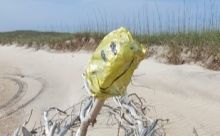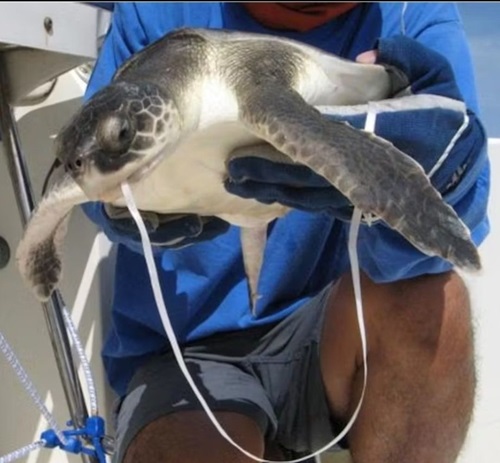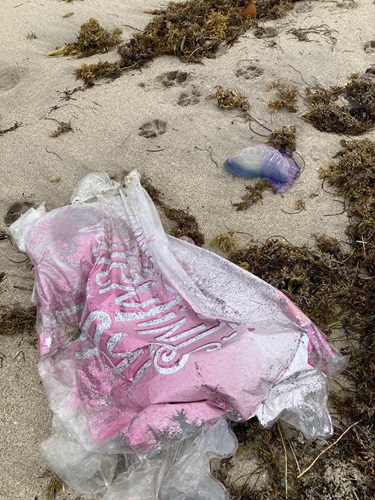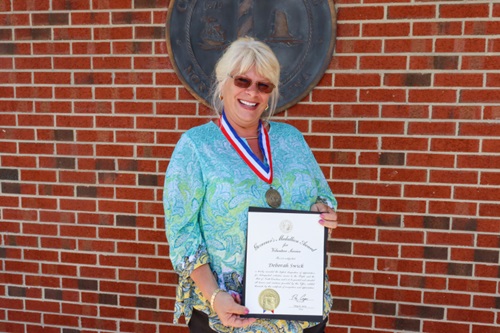
In January 2023, Southern Shores Debbie Swick was watching the local news and saw a segment that included a balloon release as a memorial for someone who had passed away. As the pink and yellow balloons sailed skyward, Swick started to cry.
“It just hit me,” she says. “I knew where those balloons were going: to the ocean.”
Swick says she always been aware of balloons’ harmful effects on the environment. Working in the restaurant and banquet industry back in New Jersey, she said she would never allow balloon releases at her events and always made sure that any balloon decorations were popped and disposed of properly.
Moving to the Outer Banks four years ago, she began volunteering with the Network for Endangered Sea Turtles NEST and the Outer Banks Marine Mammal Stranding Network and has seen firsthand how balloons affect wildlife. She has seen balloon string removed from a sperm whale during a necropsy. She has seen the jar at the North Carolina Aquarium on Roanoke Island that shows the pieces of balloons and string that have been removed from sea turtles. And, like everyone who loves the Outer Banks, she has seen countless balloons littering our beautiful beaches.
Swick decided to take action. She started speaking up, contacting as many like-minded organizations as she could and informing them about the effects of balloon litter. She spent about four months crafting a proposal that would help her convince local municipalities to enact legislation banning balloon releases and started attending town and county meetings.

In her presentation Swick points to the deadly effects of balloon litter of sea turtles, dolphins and whales, including a Gervais’s beaked whale calf that was found dead in Emerald Isle last fall; at its necropsy, it was learned that the whale died from ingesting a full balloon. She points out that the number one killer of shorebirds is balloon entanglement or ingestion and that one of the top causes of death for sperm whales is balloon ingestion. She describes that when Mylar balloons float around on the ocean, their colorful coating of metal, plastic and petroleum is rubbed off until the balloon becomes a clear floating blob that looks just like a jellyfish dinner for a sea turtle.
After attending countless meetings, Swick has been successful in getting four Outer Banks municipalities to ban balloon releases so far. Duck, Nags Head, Southern Shores and Kitty Hawk have banned balloon releases, with fines of $250 per released balloon to $50 per released balloon. Swick is on the agenda for Kill Devil Hills’ July meeting agenda and hopes the town will also implement a ban. She is working on getting Dare County to do the same. N.C. Senator Bobby Hanig is helping her work toward a possible statewide ban. Ten states across the nation have already implemented a statewide ban on balloon releases.
Swick, who is developing a reputation as the Crazy Balloon Lady, never misses a chance to educate others about the problems associated with balloon releases, whether they are intentional or accidental. She has a Facebook group, Ban Balloon Releases NC, has been interviewed by countless media outlets and is making a documentary with local videographer Benny Baldwin. She has a team of Balloon Warriors out patrolling the beaches and educating the public and has a Change.org petition too.
She also contacts organizations and businesses to educate them on the harmful effects of balloons. She convinced the Outer Banks Association of Realtors to take a stance on not using balloons on open house signs. She contacted MGM studios and asked them not to show balloon releases in movies and convinced a Virginia Beach-based TV station to not show balloon releases on the news (Virginia is one of the states that has banned balloon releases).

Swick also talks to people on the beach at NEST events. “I tell them, “Wherever you are from, you can help – never release balloons.’ Everyone needs to hear this message.”
The fact is, the balloons we find on the Outer Banks beaches could have been released thousands of miles away. Swick says the average distance a released balloon travels is 1,300 miles, and one balloon was documented to have traveled 10,000 miles.
“Because we have so many visitors here, it’s a great opportunity for us to educate people that any balloon release in the United States stands a chance of coming to the Atlantic Ocean.”
On December 27, 2023, Swick found a red Happy Holidays balloon on a frayed string on the beach near Jennette's Pier. The balloon was branded with the name of an Alabama real estate company. That balloon had traveled 750 miles and landed on the Outer Banks. Swick called the CEO of the realty company, who vowed not to provide balloons at any more events.
As any local or visitor knows, balloon trash is a common sight on the Outer Banks. In 2023 Cape Hatteras National Seashore documented the pickup of 1,786 balloons from the beach. That’s not counting the balloons that were picked up and not documented. And that’s on just a 70-mile stretch of coast. North Carolina has 3,300 miles of ocean, sound and river shoreline that need to be clean for wildlife. Commercial fishermen often tell Swick that they find balloons floating on the open ocean all the time
In addition to harming wildlife, balloons are litter. Swick says it takes 100 years for a Mylar balloon to break down, 150 years for Mylar ribbon to break down and five to six years for a latex balloon to break down. But even then, they are never fully gone as they leave behind microplastics and chemicals. At this point, there is no such thing as a fully biodegradable balloon available in the United States, but Swick says she has heard Japan might be developing one. She is hopeful that one day balloons will at least come with a warning label about releasing them.
So what’s the alternative for gender reveals, memorials, birthday parties and attention grabs? Swick likes bubbles, planting a tree, spreading flower petals – anything biodegradable, or things like pinwheels, flags or banners.
“Balloon releases are a senseless practice, and there are alternatives,” she says. “The balloons do not go to heaven. They are not out of sight out of mind.’
Swick has plans to take this further.
I would love to see the statewide ban, but then it’s about education to encourage people to be responsible,” she says. “And once N.C. adopts this, I want to go national. Let’s put an end to it. Of course plastic bags and plastic bottles deserve a battle cry as well, but I can only do so much.”

Photo: Debbie Swick recently received the N.C. Governor's Medallion Award for Volunteer Service.
And Swick does plenty.
An Outer Banks resident for only four years, Swick was recently awarded the prestigious North Carolina Governor’s Medallion Award for Volunteer Service—which is North Carolina’s highest volunteer honor—for her work as a volunteer for numerous organizations, including the Southern Shores Civic Association, Town of Southern Shores, Chicahauk Property Owners Association, Network for Endangered Sea Turtles (N.E.S.T.), Beach Food Pantry, Better Beaches OBX, Town of Kill Devil Hills Trash Attack, Dunes of Dare Garden Club, Outer Banks Woman’s Club, Mammal Stranding Stranding Network, Outer Banks Seafood Festival, Outer Banks Anglers Club and Ban Balloon Releases N.C.
You can help by never releasing balloons, picking up any balloons you find in nature, signing the Change.org petition, following the Ban Balloon Release NC Facebook page and spreading the word.
And if you see Swick around town – driving her car with Balloons Blow, Don’t Let Them Go painted on the back – give her a high five and tell her you're going to help with the cause. She's doing a great service for the Outer Banks and its wildlife.



 Molly Harrison is managing editor at OneBoat, publisher of OuterBanksThisWeek.com. She moved to Nags Head in 1994 and since then has made her living writing articles and creating publications about the people, places and culture of the Outer Banks.
Molly Harrison is managing editor at OneBoat, publisher of OuterBanksThisWeek.com. She moved to Nags Head in 1994 and since then has made her living writing articles and creating publications about the people, places and culture of the Outer Banks.

